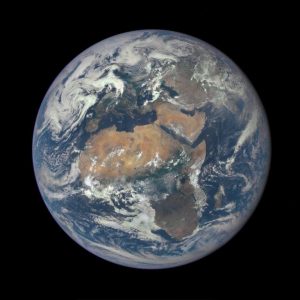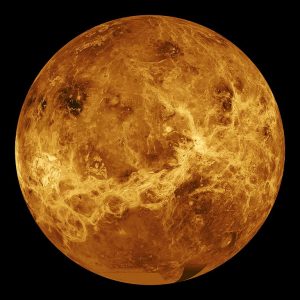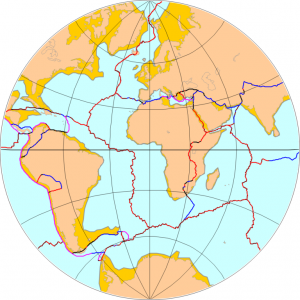27 December 2016
Random temperature fluctuations may have made Earth habitable
Posted by Lauren Lipuma

Image of Earth taken by a NASA camera on the Deep Space Climate Observatory (DSCOVR) satellite.
Credit: NASA via Flickr.
By Aylin Woodward
Random temperature fluctuations in the mantle and on the planet’s surface could be the reason Earth is a habitable world with moving tectonic plates while other terrestrial planets in the solar system are inhospitable worlds, according to new research.
New mathematical modeling suggests Earth’s plate tectonics, considered to be necessary for life to evolve, could have been kick-started by these small temperature changes rather than being predetermined during Earth’s formation, according to researchers who presented the new study at the 2016 American Geophysical Union Fall Meeting.
The finding could change the way scientists understand how a planet, and, by extension, life, evolves. Modeling planetary evolution could help scientists better understand the solar system and inform similar modeling for Earth-like extra-solar planets, said Matthew Weller, a geophysicist at the University of Texas at Austin and co-author of the new study.
“If internally two planets are exactly the same, they still might end up different due to small random fluctuations,” Weller said. “Potentially Earth and Venus could’ve actually started out the same and Earth was just lucky.”
Plates and lids
The general consensus in the planetary science community is that a mobile lithosphere—the rigid, outer part of the planet—is necessary to sustain life, Weller said. The broken-up pieces of lithosphere, called plates, are continuously being recycled at their respective boundaries in a process known as plate tectonics.

Image of Venus. The debate on this whether or not this second planet from the sun had plate tectonics at one time still rages.
Credit: Wikimedia Commons.
Volcanism at gaps between plates ensures heat and gases like water vapor and carbon dioxide in Earth’s mantle, the layer between core and crust, exit its interior. Subduction at these gaps, or the movement of one plate beneath another, ensures these same heat and gases can return to the interior to be released again later.
This release and recycling of gases is critical to producing and maintaining Earth’s atmosphere, which insulates Earth from solar radiation and makes for a buffered, warm climate capable of supporting life, Weller said. Heat recycling from inside a planet to its atmosphere and back again doesn’t happen when a planet is in a “stagnant lid regime,” where a single, continuous plate sits unmoving on top of the mantle.
Earth is the only planet in the solar system to be in a mobile-lid regime—to have a lithosphere broken up into plates. The other three terrestrial planets with comparable mantles and lithospheres—Mercury, Venus and Mars—are in a stagnant-lid regime, though some scientists would argue that Venus is in a transitional regime between mobile and stagnant lids, where its lid experiences episodic overturns, according to research by fluid dynamist Adrian Lenardic from Rice University in Houston, Texas and co-author of the new study.
Planets can transition between different regimes over time, depending on changes in internal heating and surface temperature. Scientists have been able to model plate tectonic-like regimes using the mantle’s viscosity, or resistance to steady flow in the planet’s interior, and the stress on the lithosphere, which are both responsible for fracturing of the lithosphere into different plates.
Evolutionary pathways
In the new study, Weller and his colleagues used this type of model to study a planet’s sensitivity to small temperature changes during such a transition phase. They found random temperature perturbations in the mantle and on a planet’s surface, more so than initial planetary conditions, might be responsible for the difference between, say, Earth’s plate tectonics and Venus’ semi-stagnant lid.
Even if two planets evolved identically, they can diverge due to small perturbations and random processes that affect whether a planet develops a mobile lid or a stagnant lid and whether or not this mobile lid yields Earth-like plate tectonics, Weller said.

Outlines of Earth’s eight tectonic plates, with African Plate at center.
Credit: Micheletb_Data via Wikimedia Commons.
The takeaway message from his new study is that plate tectonics, depending on when they initiate, can be a bit of a double-edged sword, he said.
According to Weller, tectonics can either catalyze an Earth-like planet with a habitable climate, or alternatively, a planet that shuts itself down when it gets too hot. the latter process, as the lithosphere initially begins to break apart into plates, the severe outgassing of greenhouse gases can raise the temperature of the atmosphere so much that the planets effectively gets cooked.
These divergent behaviors are the result of internal temperature fluctuations of at least 200 degrees Kelvin (360 degrees Fahrenheit), or surface temperature changes on the order of 10 degrees Kelvin (18 degrees Fahrenheit), according to the new study. Weller said a planet is most sensitive to such temperature changes just prior to the lithosphere breaking and surface temperature seems to play a larger role in determining the planet’s fate.
In addition, once the lithosphere firmly mobilizes, the planet’s lid is insensitive to these very same temperature fluctuations, according to the researchers. It would take a surface temperature change of 1,000 degrees Kelvin (1,800 degrees Fahrenheit) to see any sort of regime transition, Weller said.
But much like any model, Weller is hungry for more data to debunk the theory that planets’ lid regimes are predetermined by their size and initial internal temperature.
“Tectonics may not be predetermined, they may just be the result of small variations that we can’t predict,” he said.
—Aylin Woodward is a graduate student in the UC Santa Cruz Science Communication Program. Follow her on Twitter @AylinWoodward.


 GeoSpace is a blog on Earth and space science, managed by AGU’s Public Information staff. The blog features posts by AGU writers and guest contributors on all sorts of relevant science topics, but with a focus on new research and geo and space sciences-related stories that are currently in the news.
GeoSpace is a blog on Earth and space science, managed by AGU’s Public Information staff. The blog features posts by AGU writers and guest contributors on all sorts of relevant science topics, but with a focus on new research and geo and space sciences-related stories that are currently in the news.